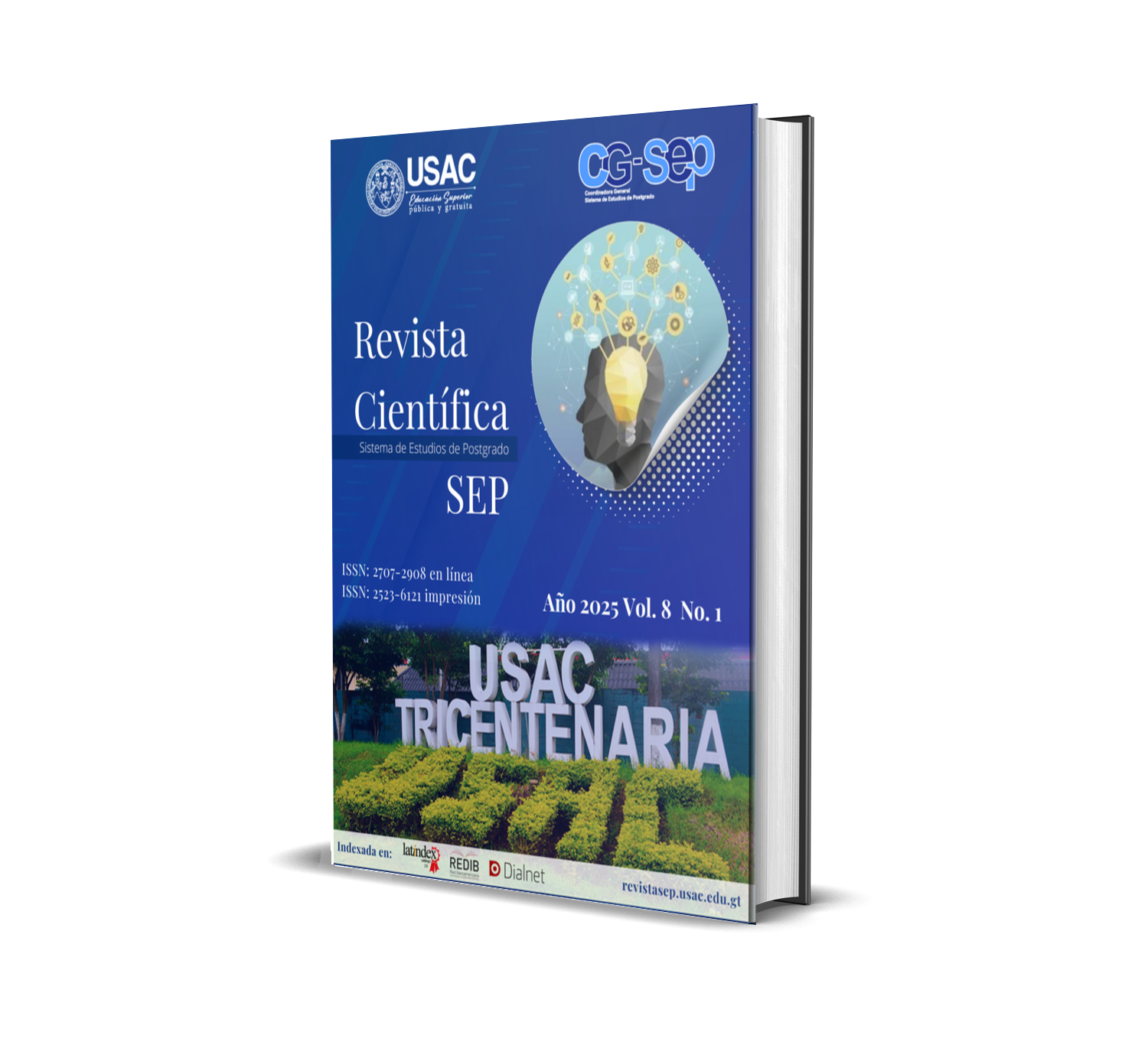The technology as a tool to obtain evidence in audits
DOI:
https://doi.org/10.36958/sep.v8i1.335Keywords:
audit technology, audit evidence, efficiency, technological evolutionAbstract
OBJECTIVE: to analyze the application of technology as a tool to obtain evidence in audits, highlighting its impact on process optimization and improved results. METHOD: a bibliographic review was conducted based on academic and technical sources. Rigorous criteria were used to construct an updated theoretical framework. Twenty articles were reviewed, and 13 were used. The collected information was systematized and analyzed to identify approaches, methodologies, and key findings on digitalization in audit processes. RESULTS: advanced technologies such as specialized software, artificial intelligence, and blockchain technology have transformed audits in Guatemala. These allow for adaptation to international standards, improved transparency, and optimized document management. Review processes have proven effective in sectors such as finance and manufacturing, increasing accuracy and efficiency. Furthermore, robotic automation helps reduce errors in repetitive tasks. However, challenges such as lack of training, resistance to change, and cybersecurity risks were identified, which hinder full adoption. CONCLUSION: appropriate technological integration modernizes audit processes and positions Guatemala as a regional benchmark. This strengthens competitiveness and confidence in financial management.
Downloads
References
Álava Rosado, M. X., Recalde Aguilar, L. M., Paredes Gavilánez, J. G. y Taranto Haon, F. X. (2023). Contribución de la auditoría interna para alcanzar una gestión eficaz. LATAM Revista Latinoamericana de Ciencias Sociales y Humanidades, 4(4), 1217-1227.
https://doi.org/10.56712/latam.v4i4.1280 DOI: https://doi.org/10.56712/latam.v4i4.1280
Avendaño Rito, M. C., Arango Ramírez, P. M. y Cruz Cruz, E. (2021). El Desempeño Económico y la Responsabilidad Social Desde la Auditoría Ambiental, Evidencia Empírica en Empresas Mexicanas. https://repositorios.fca.unam.mx/investigacion/memorias/2024/11.1.pdf
Cruz, J. E. (2020). La auditoría en entorno COVID-19. Uso de tecnología y enfoque de riesgos. Podium, (38), 67-86. http://scielo.senescyt.gob.ec/scielo.php?pid=S2588-09692020000100067&script=sci_arttext DOI: https://doi.org/10.31095/podium.2020.38.5
Cueto Herrera, A. G., Godoy Hernández, M, y Miranda Pérez, R. (2022). Obtención de una muestra en auditoria a través de métodos estadísticos en entidades del sector agrícola utilizando Microsoft Excel. Revista Científica Agroecosistemas, 10(3), 198-209.
https://aes.ucf.edu.cu/index.php/aes/article/view/579
Daza Hernández, L. E. y Montoya Quintero, D. M. (2022). Propuesta de modelo de gestión del conocimiento para auditorias de control fiscal realizadas por la Contraloría General de Medellín. Revista CEA, 8(16), 3-36. http://repositorio.itm.edu.co/handle/20.500.12622/6536 DOI: https://doi.org/10.22430/24223182.1909
Duchitanga Plasencia, A. E. y Zapata Sánchez, P. E. (2024). La auditoría forense: un análisis integral desde una perspectiva conceptual y metodológica. Revista Metropolitana De Ciencias Aplicadas, 7(2), 129-141. https://doi.org/10.62452/jpjbrs16 DOI: https://doi.org/10.62452/jpjbrs16
Fajardo Pérez, M. E. (2019). Auditoría operacional al ciclo de tesorería en una cooperativa de ahorro y crédito federada en Guatemala. Universidad de San Carlos de Guatemala. http://www.repositorio.usac.edu.gt/id/eprint/13622
Fernández Valiente, J. C. (2022). El desafío de las tecnologías emergentes para la práctica de la auditoría externa impositiva en tiempos de pandemia. Revista de ciencias empresariales, tributarias, comerciales y administrativas, 1(1), 23-41. DOI: https://doi.org/10.58287/rcfotriem-1-1-2022-2
https://educaciontributaria.com.py/revista/index.php/rcetca/article/view/2
Gómez Palanques, N. y Rodríguez García, F. (2021). Las nuevas tecnologías y su impacto en el sector de auditoría. https://diposit.ub.edu/dspace/handle/2445/179365
Martínez Cordero, C. (2024). Diagnóstico y Evaluación Organizacional. Investigación Y Ciencia Aplicada a La Ingeniería, 7(44), 69-76.
https://ojsincaing.com.mx/index.php/ediciones/article/view/356
Morales Tobar, J. E. (2022). Diseño de investigación para el desarrollo de un prototipo de aplicación móvil de auditoría energética domiciliar para fomentar la mejora de la eficiencia energética en los hogares de la ciudad de Guatemala. Universidad de San Carlos de Guatemala. http://www.repositorio.usac.edu.gt/19148/
Sosa Matta, A. D. (2023). Diseño de investigación de metodología de auditoría energética en un centro de distribución de productos cárnicos refrigerados en la República de Guatemala. Universidad de San Carlos de Guatemala. http://www.repositorio.usac.edu.gt/19108/1/Alejandro%20David%20Estuardo%20Sosa%20Matta.pdf
Valladares Albarracín, J. J. y Ordóñez Parra, Y. L. (2024). La aplicación de inteligencia artificial en la auditoría contable [The application of artificial intelligence in accounting auditing]. Revista Multidisciplinaria Perspectivas Investigativas, 4(especial), 73-85.
http://www.rperspectivasinvestigativas.org/index.php/multidiscipinaria/article/view/172
Published
How to Cite
Issue
Section
License
Copyright (c) 2025 Dora Ligia Kestler Soto

This work is licensed under a Creative Commons Attribution 4.0 International License.
The authors who publish in this journal accept the following conditions:
- The authors retain the copyright and assign to the journal the right of the first publication, with the work registered with the Creative Commons 4.0 attribution license, which allows third parties to use what is published as long as they mention the authorship of the work already the first publication in this magazine.
- Authors may make other independent and additional contractual agreements for the non-exclusive distribution of the version of the article published in this journal (eg, include it in an institutional repository or publish it in a book) provided that they clearly indicate that the work it was first published in this magazine.
- Authors are allowed and encouraged to share their work online (for example: in institutional repositories or personal web pages) before and during the manuscript submission process, as it can lead to productive exchanges, more and more quick citation of published work (see The Effect of Open Access).









